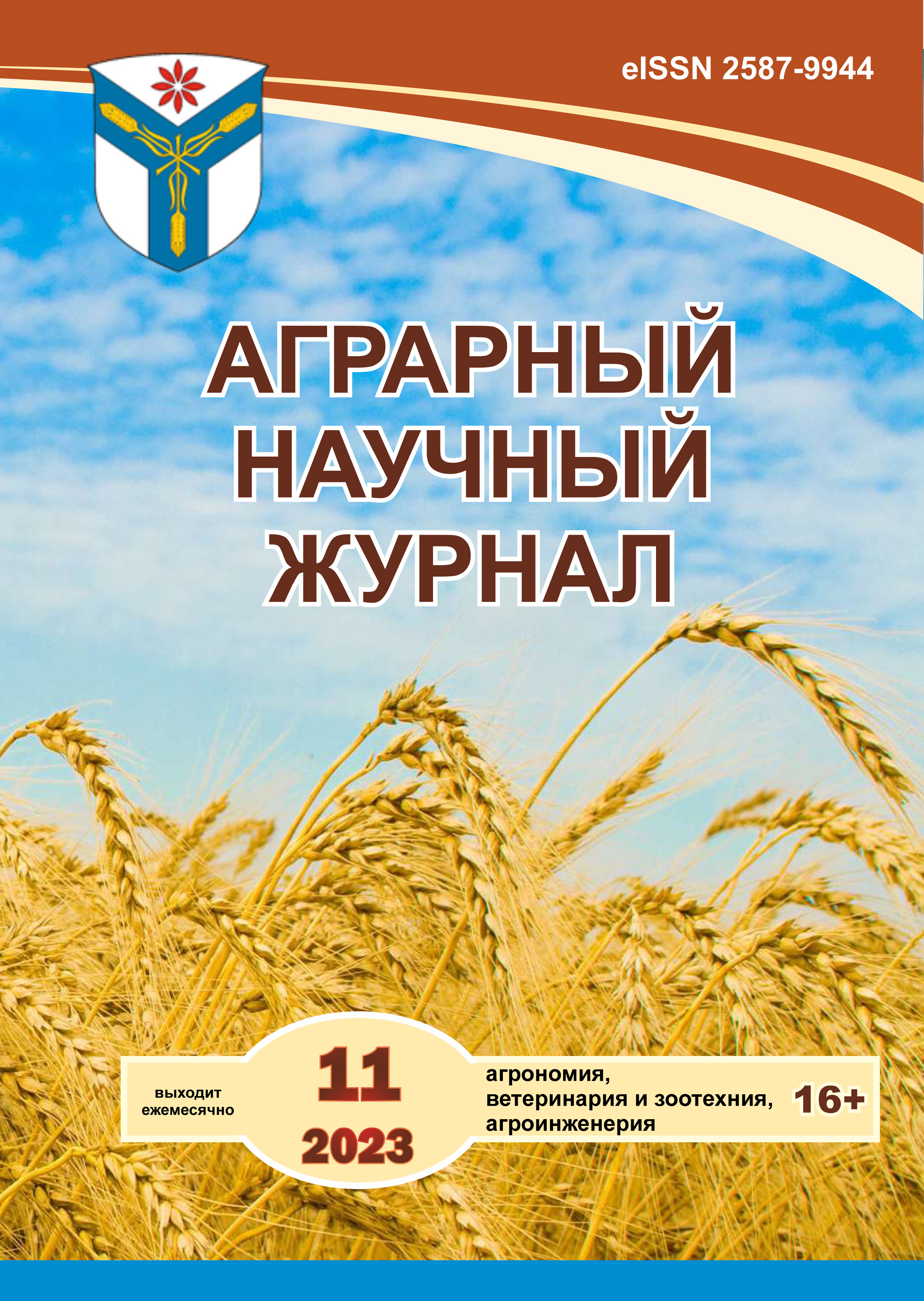Climate-oriented breeding of spring barley in arid regions
DOI:
https://doi.org/10.28983/asj.y2023i11pp74-82Keywords:
variety, breeding line, productivity, plasticity, stability, drought resistanceAbstract
The article presents the results of the study of collection samples of spring barley. The aim of the research was to assess the prospects of breeding lines of spring barley for the agro-industrial complex of regions with different climate aridity. The studies were carried in 2011-2021 out at the Krasnokutskaya breeding experimental station (experimental field coordinates 50.914000, 47.068300, Krasnokutsky district of the Saratov region). Predecessor - fallow, accounting area of plots - 25 sq.m. During the period of study of the material, 2012, 2013, 2014, 2015 and 2018 were dry years (the total precipitation during the growing season was 42.8-50.3 mm, HTC 0.30-0.46). In 2019, spring barley crops almost died due to a severe frost in the three-leaf phase and the subsequent severe drought (only 4.9 mm of precipitation fell during the growing season, the HTC was 0.03), so data for this year are not provided. As relatively favorable, 2011, 2016, 2017, 2020 and 2021 can be distinguished (the total precipitation for the growing season is 81.0-135 mm, HTC 0.61-0.97). During 2011-2021 indicators of productivity, plasticity, stability and drought resistance of spring barley varieties bred over a 100-year period at the Krasnokutsk breeding experimental station were evaluated. It was revealed that the average productivity of barley varieties increased by 57.9%, and in the years of acute droughts it almost doubled. Analysis by the same parameters of 5 promising lines in 2017-2021. made it possible to differentiate their potential for regions with different aridity. In the zone with low aridity (more than 7 million hectares of arable land in the Right Bank of the Saratov, Penza and Samara, Volgograd, Ulyanovsk regions), the Nutans 244 and Medicum 276 lines, which are responsive to additional moisture, have the greatest potential. In areas with moderate aridity (about 10 million hectares arable land in the Lower Volga region), samples Nutans 296 and Medicum 247 will have an advantage. In areas with high aridity (more than 6 million hectares of arable land in the Left Bank of the Saratov, Volgograd, Astrakhan regions, Kalmykia), the Medicum 270 line can show high efficiency. These features will be taken into account during further transfer to variety testing.
Downloads
References
Агробиологическая характеристика кормового сорта ярового ячменя Саша / П. В. Поползухин [и др.] // Достижения науки и техники АПК. 2019. Т. 33. № 1. С. 27–29. DOI: 10.24411/0235-2451-2019-10106.
Адаптивность потенциала сортов ярового ячменя селекции Омского аграрного научного центра / П. Н. Николаев [и др.] // Земледелие. 2019. № 1. С. 35–38. DOI: 10.24411/0044-3913-2019-10110.
Губарев Д. И., Левицкая Н. Г., Деревягин С. С. Влияние изменений климата на деградацию почв в аридных зонах Поволжья // Аридные экосистемы. 2022. Т. 28. № 1(90). С. 20–27. DOI: 10.24412/1993-3916-2022-1-20-27.
Долгосрочная стратегия развития зернового комплекса Российской Федерации до 2035 года // garant.ru.
Долженко Д. О., Шевченко С. Н. Генетический контроль показателей выхода зерна в диаллельном комплексе ярового ячменя // Достижения науки и техники АПК. 2020. Т. 34. № 10. С. 34–42. DOI: 10.24411/0235-2451-2020-11005.
Доспехов Б. А. Методика полевого опыта. М.: Альянс, 2014. 351 с.
Ильин А. В., Шарганова И. А., Деревягин С. С. Новый сорт ярового ячменя Граник // Зерновое хозяйство России. 2021. № 4. С. 23–27. DOI: 10/31/367/2079-8725-2021-76-4-23-27.
Кривченко В. И. устойчивость зерновых колосовых к возбудителям головневых заболеваний. М.: Колос, 1984. 302 с.
Максимов Р. А., Киселёв Ю. А. Новый сорт ярового ячменя Памяти Чепелева // Достижения науки и техники АПК. 2018. Т. 32. № 8. С. 51–55. DOI: 10.24411/0235-2451-2018-10813.
Методика государственного сортоиспытания сельскохозяйственных культур. М., 2019. 329 с.
Новохатин В. В., Драгавцев В. А. Научное обоснование эколого-генетической селекции мягкой яровой пшеницы // Достижения науки и техники АПК. 2020. т. 34. С. 39-46. DOI: 10.24411/0235-2451-2020-11206.
Нормы и рационы кормления сельскохозяйственных животных / А. П. Калашников [и др.]. М.: Агропромиздат, 1985. 351 с.
Оценка исходного материала ячменя в условиях Ростовской области / Е. Г. Филиппов [и др.] // Зерновое хозяйство России. 2022. № 1(79). С. 3–10. DOI: 10.31367/2079-8725-2022-79-1-3-10.
Радюкевич Т. Н., Пасынкова Е. Н. Оценка элементов структуры урожая и определение адаптационной способности новых сортов ярового ячменя зарубежной селекции на Северо-Западе России// Достижения науки и техники АПК. 2020. Т. 34. № 12. С. 52–55. DOI: 10.24411/0235-2451-2020-11208.
Степановских А. С. Головнёвые болезни ячменя. Челябинск: Южн. Урал. кн. изд-во, 1990. 396 с.
Столпивская Е. В. Исходные формы ярового ячменя для селекции на продуктивность в условиях Среднего Поволжья // Аграрная наука. 2020. № 11-12. С. 72–75. DOI: 10.32634/0869-8155-2020-343-11-72-75.
Томмэ М. Ф. Корма СССР. М., 1964. 446 с.
Хангильдин В. В. О принципах моделирования сортов интенсивного типа // Генетика количественных признаков сельскохозяйственных растений. М.: Наука, 1978. С. 111–116.
Eberhart S. A., Russel W. A. Stability parameters for comparing varieties // Crop Science. 1966. Vol. 6. No. 1. P. 36–40.
Downloads
Published
Issue
Section
License
Copyright (c) 2023 The Agrarian Scientific Journal

This work is licensed under a Creative Commons Attribution-NonCommercial-NoDerivatives 4.0 International License.








